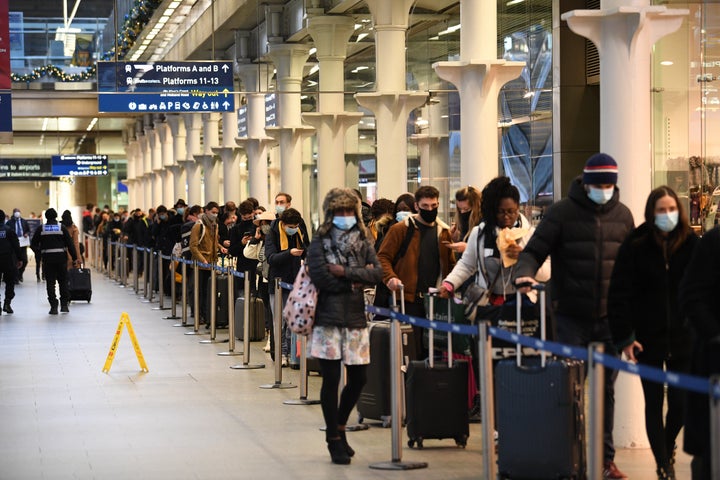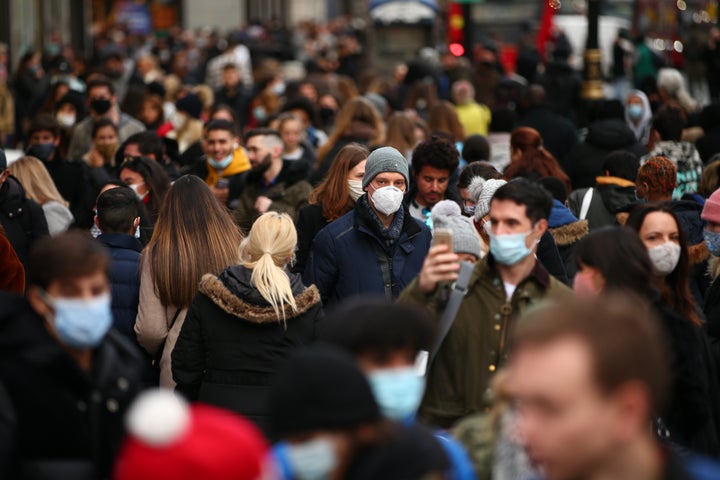A new mutant coronavirus strain sweeping the UK has sparked last-minute tier 4 lockdowns across the south of England.
The new variant of SARS-CoV-2, which goes by the name B.1.1.7, has also led to drastic new tier 4 restrictions in areas affected amid fears it is spreading rapidly across the country.
London and parts of the east and south-east of England are already in tier 4. And on Wednesday, it was announced that Sussex, Oxfordshire, Suffolk, Norfolk, Cambridgeshire, all of Essex, Waverley in Surrey, Hampshire including Portsmouth, and Southampton excluding the New Forest would be escalated to tier 4 on Boxing Day.
Here’s what we know so far about how the new mutation – nicknamed Covid-20 – spreads.
How fast is it spreading?
The new variant of Covid-19 is believed to have first appeared in mid-September in London or Kent. By the middle of November, it is thought to have accounted for about 26% of cases in London and other parts of south-east England. Over the past week, that proportion has now risen to more than 60% of new cases in London.
Meanwhile the latest figures show cases have risen by 57% over the past week and hospital admissions are at 1,909 a day - the highest figure since April. A further 744 daily deaths were recorded following a positive Covid-19 test, also the highest number since April.
Professor Chris Whitty, chief medical officer for England, has said the new variant could be up to 70% more transmissible than the original strain of the disease and could increase the R-value by 0.4 or more.
In a summary by the government’s New and Emerging Respiratory Virus Threats Advisory Group (Nervtag), experts said they had “moderate confidence” that the variant has shown a substantial increase in transmissibility compared with other variants.
But what does a 70% increased transmissibility actually mean?
Dr Andrew Lee, a public health and disease control specialist at the University of Sheffield, explains: “Let’s say if the current effective reproductive number is one, that means if 10 people were infected it would infect 10 others.
“If 10 people were infected with this new strain, instead of infecting 10 others they would be infecting 14 other people. That’s basically what 70% more transmissible means.”
Dr Justin O’Grady, group leader at the Quadram Institute and a medical microbiology professor at the University of East Anglia (UEA), says the transmissibility of this new mutation is due to its spike protein’s receptor-binding domain. In other words...
“One of the mutations appears to enhance how well a virus is able to attach itself to human cells in the body, while the other seems to be helpful in evading the immune system,” he told HuffPost UK.
How serious is it?
As Whitty said during Saturday’s press conferences, “viruses mutate all the time”. Based on the data so far, there is no evidence that the new strain increases the risk of severe illness or the mortality rate.

There is also no evidence to suggest the UK mutation affects coronavirus treatments and vaccines. “Our working assumption at the moment, from all of the scientists, is that the vaccine response should be adequate for this virus,” Whitty said. “That obviously needs to be looked at going forward, and we need to keep vigilant about this.”
On Monday, Johnson announced that 500,000 people had been vaccinated against Covid so far in the UK.
However, even if the new strain doesn’t raise the risk of severe disease, the danger is that it does put our health system at risk. “We’ve been trying to slow down the increase of cases in the country so that we can protect the NHS, so this means the problem is going to raise its head again,” says O’Grady.
“The disease severity could stay the same, but the virus will transmit faster among people. The higher the transmission rate, the higher the [number] of people who will not react well to the infection and therefore will have to go to hospital.
“If hospitals are being overrun very quickly, that will mean doctors will have to make very difficult decisions as to who lives, and who dies.”
Who is it infecting?
In the report by Nervtag, experts concluded there is “currently insufficient data to draw any conclusion” on the age distribution of cases, adding that better data would arrive later this week on which age groups were impacted by this variant.
“We don’t know if there’s a predilection for any particular age group or ethnicity yet,” says Lee. “So watch this space.”
But speaking on BBC Radio 4′s Today programme, Professor Neil Ferguson said there was a possibility that children were being “slightly” more affected by this new strain.
When asked about possible school closures, he replied: “So undoubtedly increased transmissibility limits our options for manoeuvre even more, and there is a hint from the data that this variant may infect children slightly more effectively than the previous variants, so it’s very difficult to prove causality.
“It’s just too early to tell. It is going to be difficult, no doubt about that [...] but it’s too early to say precisely what additional measures might be needed.”
O’Grady agrees that there isn’t sufficient evidence to say whether the new strain has a greater impact on certain age groups than previous ones.
“What we do know is that previous lineages did transmit through kids, so if we assume that this new lineage is more transmissible then it’s potentially more transmissible in children as much as in adults,” he says. “But we don’t have the data yet to show that.”
Could it become the dominant variant?
As Lee describes it, the new strain has “mushroomed exponentially” since it was first detected around September. “Genomic surveillance in the south has shown that it has a selective advantage over the other strain and is rapidly displacing it.

“If the strain has a selective advantage, it becomes the dominant strain. What will happen is that it will evolve and become much more widespread throughout the UK – and probably elsewhere, which is why Europe and other countries are so concerned about it. It wouldn’t surprise me if it is a matter of time before it becomes the dominant strain.”
O’Grady adds: “At the current rate, it appears to be transmitted around 1.5 times to two times faster than other lineages, therefore there’s a strong possibility that it will go on to dominant the lineages that we see in the UK.”
On Wednesday, health secretary Matt Hancock said another new strain linked to South Africa has been detected in the country – one that could be even more infectious than the B.1.1.7 strain.
Speaking at a Downing Street briefing, he said the two cases of the new variant had travelled to South Africa “over the past few weeks”, adding: “This new variant is highly concerning because it is yet more transmissible and it appears to have mutated further than the new variant that has been discovered in the UK.”
Transport secretary Grant Shapps has now stopped flights entering the UK from the country.
Does this change our safety measures?
For now, no. “I don’t think there are going to be any changes in that regard,” says O’Grady. “Continue to do what you’ve been advised to do: wash your hands, keep your two-metre distance, try to avoid indoor socialising with multiple households, don’t go to work if you can possibly avoid it, don’t go to restaurants or bars.
“We know those things will reduce transmission – the issue is that people haven’t been complying to those guidelines. If everybody follows those rules, we could bring down R value significantly. We just have to get people to take it really seriously again and for people to realise that it will have a major impact on the NHS if we don’t.”
What don’t we know yet?
Aside from who precisely is most susceptible to the new strain, and how that differs from previous strains, we can’t yet say for sure exactly how much it is directly responsible for the spikes in different parts of the country.
Dr Muge Cevik, a member of Nervtag, has cautioned that the data we have so far is preliminary and based on modelling. “We don’t know how much and we don’t have absolute certainty,” he said. “Right now, we can’t make a causal relationship – it’s only an association effect.”
O’Grady believes we will know a lot more about this new variant very soon. “It won’t be long before we can answer some of these questions,” he says. “I think we’ll find out a lot of these things in a week, and within two weeks we’ll know the answers to a lot more.
“People are working extremely hard over the Christmas period to try to answer a lot of these questions. We’ll be working all the way through the holidays to try and sequence as many genomes as we can to add to the data that’s required to understand more about this strain.”
Should we be worried?
“Don’t panic,” Lee says. “We just need to be cautious because there’s a lot we don’t yet know about this new virus mutation at this point in time. For now, we don’t believe it’s more lethal, we don’t think it’s going to affect the vaccine, and our tests are still able to detect it in the PCR [polymerase chain reaction] tests.
“A lot of what we’re doing now carries on the same. It’s just a matter of being more cautious rather than unnecessarily worrying about it.”
O’Grady adds: “I’m not more concerned about this strain [than the previous ones],” says O’Grady. “It’s no more of a potential threat than it was to an individual.
“The issue is that it may spread quicker and so more people will end up in hospital and therefore die. We were hoping to protect those people by getting the vaccines out quickly and not letting them get this in the first place. If the virus transmits faster than those people are more in danger now because they will end up in hospitals and the hospitals may be overrun.
“So for society, it could be a bigger threat.”

